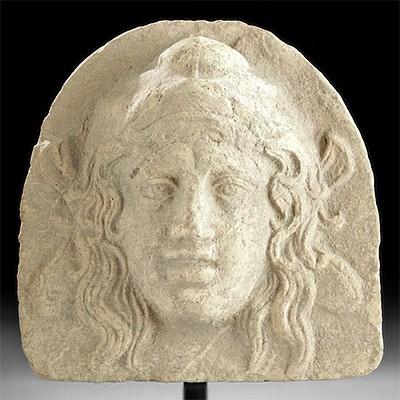Rare Egyptian Mummified Nile Perch w/ X-Ray
Lot 7
About Seller
Artemis Fine Arts
686 S Taylor Ave, Ste 106
Louisville, CO 80027
United States
Selling antiquities, ancient and ethnographic art online since 1993, Artemis Gallery specializes in Classical Antiquities (Egyptian, Greek, Roman, Near Eastern), Asian, Pre-Columbian, African / Tribal / Oceanographic art. Our extensive inventory includes pottery, stone, metal, wood, glass and textil...Read more
Categories
Estimate:
$6,000 - $8,000
Absentee vs Live bid
Two ways to bid:
- Leave a max absentee bid and the platform will bid on your behalf up to your maximum bid during the live auction.
- Bid live during the auction and your bids will be submitted real-time to the auctioneer.
Bid Increments
| Price | Bid Increment |
|---|---|
| $0 | $25 |
| $300 | $50 |
| $1,000 | $100 |
| $2,000 | $250 |
| $5,000 | $500 |
| $10,000 | $1,000 |
| $20,000 | $2,500 |
| $50,000 | $5,000 |
| $100,000 | $10,000 |
| $200,000 | $20,000 |
About Auction
By Artemis Fine Arts
Feb 27, 2020
Set Reminder
2020-02-27 10:00:00
2020-02-27 10:00:00
America/New_York
Bidsquare
Bidsquare : VARIETY SALE | Antiquities & Ethnographic Art
https://www.bidsquare.com/auctions/artemis-gallery/variety-sale-antiquities-ethnographic-art-4920
Around the world & back in time - be amazed at the treasures you will find. Antiquities from Egypt, Greece, Italy and the Near East, Asian, Pre-Columbian, African / Tribal / Oceanic, Native American, Spanish Colonial, Russian Icons, Fine Art, much more! Artemis Fine Arts info@artemisgallery.com
Around the world & back in time - be amazed at the treasures you will find. Antiquities from Egypt, Greece, Italy and the Near East, Asian, Pre-Columbian, African / Tribal / Oceanic, Native American, Spanish Colonial, Russian Icons, Fine Art, much more! Artemis Fine Arts info@artemisgallery.com
- Lot Description
Ancient Egypt, Third Intermediate Period or later, ca. 1000 to 332 BCE. A mummified Nile perch, a type of fish sacred to the goddess Neith. The mummified fish was bound with a few strands of palm fiber which are visible in the included X-ray images, especially around the tail. It was then wrapped tightly in linen bandages with some bandages near the head a darker color to create a pattern on the mummy - a common practice with animal mummies. The fish was likely mummified at Esna, on the west bank 55 km south of Luxor. This city was also known as Latopolis, in honor of the Nile perch, Lates niloticus. The fish was abundant in this stretch of the river and appears in numerous sculptures and other sacred artwork. Size: 3.1" W x 19" H (7.9 cm x 48.3 cm); size of plastic case: 6.2" L x 22.2" W x 4.35" H (15.7 cm x 56.4 cm x 11 cm)
The ancient Egyptians mummified many different animals, especially those sacred to their various gods - though they also mummified beloved pets and animals intended to be food in the afterlife. This fish, and millions more, were mummified as votive offerings - made by priests, and sold to pilgrims and worshippers who wished to gain the favor of the deity with that animal form. This authentic example is a rare one, as X-ray technology has revealed many "mummies" to have been ancient fakes - made by unscrupulous Egyptians selling linen wrappings of dirt, broken pottery, wood, or other materials to the gullible.
Provenance: private J.H. collection, Beaverton, Oregon, USA, acquired around 2008 to 2009; ex-Ancient Resource, Los Angeles, California, USA
All items legal to buy/sell under U.S. Statute covering cultural patrimony Code 2600, CHAPTER 14, and are guaranteed to be as described or your money back.
A Certificate of Authenticity will accompany all winning bids.
We ship worldwide and handle all shipping in-house for your convenience.
#150052See the x-ray images to view the animal inside. The spine is fractured, which is very common with ancient fish mummies. The linen has wear, including some unraveling and staining, commensurate with age. The mummy also has a distinctive smell common with mummies. This example comes in a modern plastic case which has several cracks in the plastic, mainly at the corners and on one side.Condition
- Shipping Info
-
All shipping is handled in-house for your convenience. Your invoice from Artemis Gallery will include shipping calculation instructions. If in doubt, please inquire BEFORE bidding for estimated shipping costs for individual items.
-
- Buyer's Premium



 EUR
EUR CAD
CAD AUD
AUD GBP
GBP MXN
MXN HKD
HKD CNY
CNY MYR
MYR SEK
SEK SGD
SGD CHF
CHF THB
THB
















